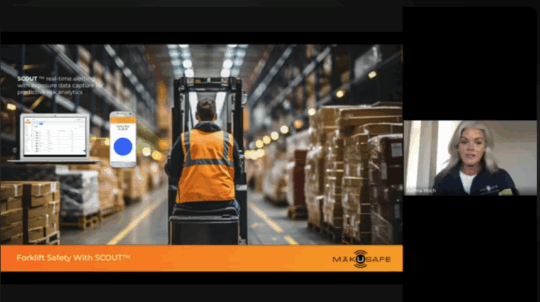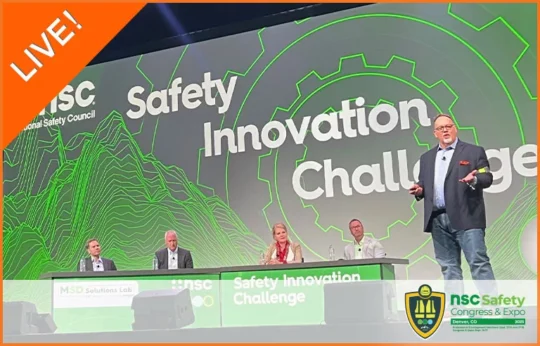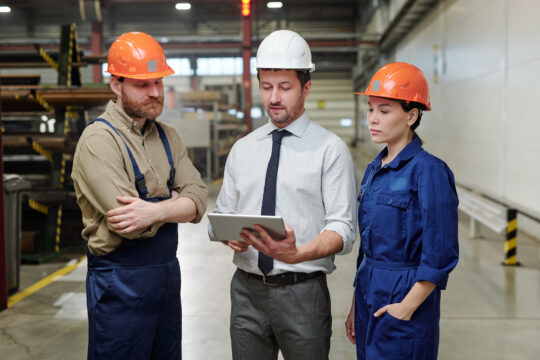MakuSafe & Safeopedia Article – How Data From Workforce Wearables Is Impacting EHS
December 20, 2019
Jessica Barrett | December 20, 2019
Presented by: Makusafe

Caption: Construction team
Source: lamontak590623 / iStock
Takeaway: Workplace wearable tech is best used to track the environmental conditions that surround workers, not personal biometric data.
As the world becomes increasingly connected and data-driven, acceptance of wearable technology continues to grow, and so does the range of applications for its use. Companies are starting to truly understand how workforce wearables can help them collect and analyze valuable information to benefit their business strategies and their workers. So much so, in fact, that analysts are predicting double-digit growth in the number of wearable devices shipped over the next five years.
While workforce wearables can help augment worker abilities and increase productivity, perhaps one of the most important applications is the improvement of safety.
In this article, we’ll look at how these wearables work, how businesses can use machine learning and AI to identify safety trends and take action to prevent incidents, and why monitoring leading indicators is key to creating a safer work environment. We’ll also look at a real-life use case scenario.
How Workforce Wearables Work
Wearable technology for the workforce can be used in a number of different ways. An application that has significant potential though is monitoring the unique work environment each individual worker is exposed to by having them wear non-invasive sensors. These sensors are discrete enough not to interrupt worker productivity, cause any discomfort, or become a burden while carrying out the job. But they are also sensitive enough to monitor things like environmental conditions that may lead to fatigue, impact productivity, or abnormal movements that could indicate a potential hazard (like a trip).
(Learn more about Using Wearable Tech to Enhance Worksite Safety.)
Rather than collecting personal biometric data, it may be more valuable (and helps avoid worker resistance) to use wearable tech to look outward to monitor hazards and risks in the work environment in real-time. You’re not interested in information when everything is status quo; you want to know about the conditions in the work environment when something happens. It contributes to strengthening organizational cultures when workers understand that they aren’t being tracked, only data about their surroundings is.

This data is used by leaders to reduce risks, and ensure the health and safety of their most valuable resource, their people.
Using AI and Machine Learning to Identify Safety Trends
While technology is capable of generating a lot of data, more isn’t always better. Employers must be sensitive to issues surrounding this. One is not constantly interrupting workers to tell them they’re doing something wrong. Instead providing intelligence to leaders enables them to make better decisions affecting their people. Another would be alert fatigue, which happens when there are so many alerts that leaders become desensitized to them.
Luckily, there’s a great way around this! Machine learning makes it possible for these systems to crunch the data from sensors and generate alerts only when necessary – that is, only when there are trends or occurrences that require attention.
Free Webinar: How Workforce Wearable Data Is Impacting Worker Safety Today!
Learn how wearable safety technology, machine learning, AI and cloud computing are helping safety leaders gain valuable insight into understanding workplace risks, keeping workers safe, and mitigating hazards before incidents occur.REGISTER NOW
So, what requires attention? As noted earlier, the point of wearable tech systems isn’t to monitor worker behavior. Rather, it’s to identify key leading indicators, such as environmental conditions and high-risk motion, and to automatically capture details about what is happening (and where) as certain thresholds are approached. It’s about identifying things that are out of the “normal” range so that they can be investigated further.
Sound exposure, and air quality impact worker health and wellbeing. Things like temperature, light levels, humidity, impact fatigue and productivity. Front line observations and good-catches provide insight into exposure, and can be used to mitigate risks and send more people home safely each day.
(Find out How Machine Learning Will Reduce Workplace Accidents.)
This approach is key because it provides safety leaders with critical information about near misses (85% of which generally go unreported) without requiring the worker to interrupt their day to manually file a report.
Beyond this, machine learning and AI also make it possible to generate solutions to an identified hazard at the moment of need: recommended action steps and prescribed remediation suggestions based on best practices, specialist information, and company or insurer loss-control resources. This is particularly helpful for organizations that don’t have a full-time, dedicated safety manager and leaves no room for ambiguity about what requires immediate attention and how best to deal with it.
Facilitating Proactive Action to Prevent Incidents: A Use Case
MakuSafe, a SAAS company that creates patented, award winning, wearable tech specifically to improve worker safety, recently completed 120-day pilot projects with a range of strategic partners in six states using its go-to-market hardware. During this period, the system gathered over 15 million data points and workers logged 75,000 wearable hours. The MakuSafe system detected over 300,000 indicators of potential safety hazards, which allowed frontline safety leaders to investigate the daily occurrences and identify risks and solve problems, before incidents actually occurred.
In one instance, the wearable devices detected forceful, repetitive motion from several workers at a workstation. The machine learning models did not identify the motion as a slip, trip, or fall, so safety leaders discussed it work workers. It turned out that a particular machine periodically jammed, so several times a day, workers bent over in a compromising position to forcefully pull the material free – a position that could have led to exertion or strain incidents involving the back or shoulders. Furthermore, they shut the machine down using the light curtain shutoff, the last line of defense against injuries. Once made aware of this hazard, safety leaders were able to re-engineer the process and provide refresher training on shut-down procedures for the machine.
There’s little doubt that, in time, someone would have been injured by this hazard. But the information collected by MakuSafe’s armband devices worn by workers allowed safety leaders to take proactive steps to mitigate the risk by adjusting work processes and providing additional safety training.
Final Words
As technology continues to evolve and AI and machine learning get “smarter,” we’ll see even greater crossover between workplace safety and tech.
Businesses that choose not to invest will miss out on the valuable insights that wearable technology offers for understanding safety risks in the workplace and mitigating hazards before incidents and claims occur – both of which help create safer workplaces and translate into potentially tens, if not hundreds of thousands of dollars saved.
To learn more, register for the upcoming webinar “How Workforce Wearable Data Is Impacting Worker Safety Today,” taking place on January 9, 2020.






